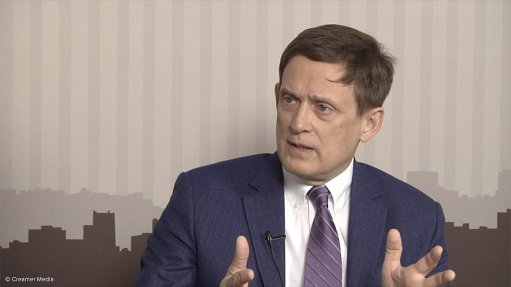
CPM Group MD Jeffrey Christian
Photo by: Creamer Media
Tri-metal catalysts, which use three platinum-group metals (PGMs) rather than two and thereby balance PGMs demand, have a multidecade history of curbing petrol vehicle emissions, which poses questions over why their re-adoption should be so protracted.
New York-based CPM Group MD Jeffrey Christian recalled in an interview with Engineering News & Mining Weekly during his visit to South Africa last month that tri- metallic catalysts were the dominant catalysts from the seventies, through the eighties and into the nineties.
Christian’s comment follows the recent announcement that specialised chemicals company BASF had successfully finished developing a tri-metal PGM catalyst – but comments surrounding this were that adoption would likely take two to three years.
Christian recalled that catalytic converter company Engelhard Corporation had supplied the tri-metal catalysts prior to being acquired by BASF.
Importantly, tri-metal catalysts enable the partial substitution of palladium with platinum in light-duty petrol vehicles, without compromising emission standards, something which is urgently needed currently to lower the demand for palladium and rhodium, which are in deficit, and to increase the demand for platinum, which is in surplus.
The tri-PGMs approach would likely substitute between 20% and 50% of the palladium currently used with platinum and provide a better demand balance.
Precious metals mining companies Sibanye- Stillwater and Implats collaborated with BASF in developing the tri-metal catalyst technology, which Sibanye-Stillwater CEO Neal Froneman described as a timely solution and Implats CEO Nico Muller said was good news that boded well for platinum.
Although more palladium than platinum is produced yearly, automotive demand for palladium is roughly three times higher than for platinum. “This structural deficit in the palladium market has resulted in sustained market deficits in palladium – contrasting sharply with platinum market surpluses,” Sibanye-Stillwater noted.
The increase in palladium demand is in large part caused by a market imbalance as a result of tightening vehicle emission regulations in China, Europe and India, as well as a market shift from light-duty diesel to light-duty petrol vehicles in Europe. This is resulting in higher costs for automotive manufacturers, which tri-metal catalysis is able to ameliorate.
The New York-based head of CPM – a long- standing specialist firm that provides commodities research, consulting, financial advisory and commodities management – recalled that palladium’s propensity to become coated with residual lead and sulphur from the petrol resulted in palladium-intense catalysts becoming less effective.
This prompted the moving of the catalyst closer to the engine so that temperature could burn off the sulphur and lead and allow more palladium to be used.
Although this was initially resisted, the 1991 collapse of the Soviet Union saw large volumes of low-priced palladium coming onto the market, resulting in the automotive industry using more palladium and less platinum.
“The flip side now is the positioning of the catalyst further from the manifold and allowing it to run at a cooler temperature so that more platinum and less palladium can be used.